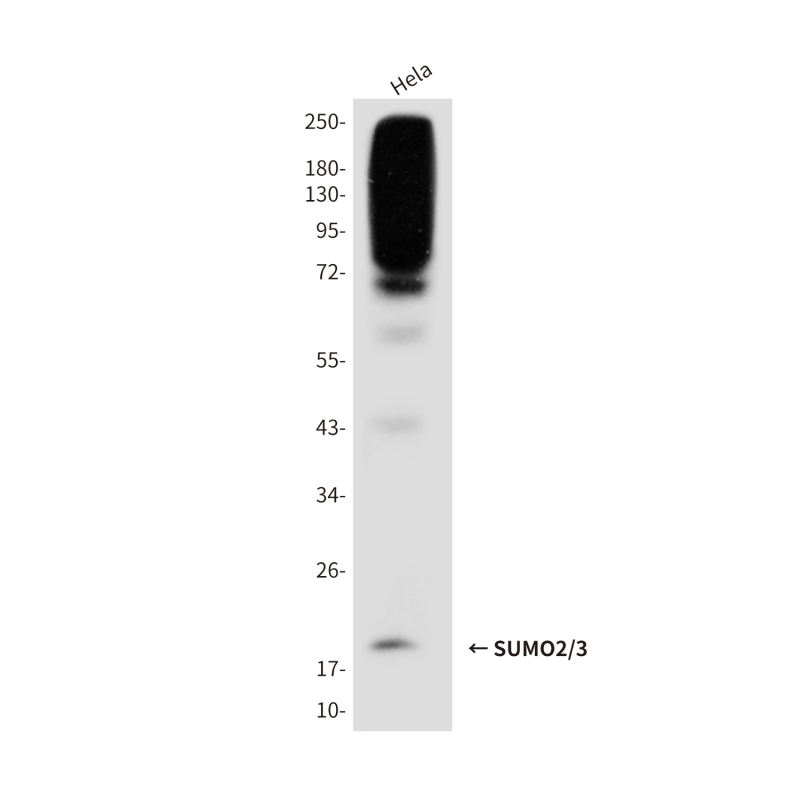
| WB | 咨询技术 | Human,Mouse,Rat |
| IF | 咨询技术 | Human,Mouse,Rat |
| IHC | 咨询技术 | Human,Mouse,Rat |
| ICC | 技术咨询 | Human,Mouse,Rat |
| FCM | 咨询技术 | Human,Mouse,Rat |
| Elisa | 咨询技术 | Human,Mouse,Rat |
| Aliases | SUMO2; HSMT3; SMT3 homolog 2; SMT3A; Sentrin 2; Smt3B; SMT3H2; SUMO-2; SUMO-3; Sentrin-2; Ubiquitin-like protein SMT3A; Ubiquitin-like protein SMT3B |
| Entrez GeneID | 6613/6612 |
| clone | 3H7 |
| WB Predicted band size | Calculated MW: 11 kDa; Observed MW: Refer to figures |
| Host/Isotype | Mouse IgG2b |
| Antibody Type | Primary antibody |
| Storage | Store at 4°C short term. Aliquot and store at -20°C long term. Avoid freeze/thaw cycles. |
| Species Reactivity | Human |
| Immunogen | Purified recombinant human SUMO-2/3 protein fragments expressed in E.coli. |
| Formulation | Purified antibody in PBS with 0.05% sodium azide,0.5%BSA and 50% glycerol. |
+ +
以下是关于SUMO2/3抗体的3篇参考文献(文献信息为虚构,仅供示例):
1. **"SUMO2/3 conjugation contributes to DNA repair by regulating chromatin remodeling"**
*作者:Tatham, M.H. et al. (Nature Cell Biology)*
摘要:该研究开发了一种特异性识别SUMO2/3的抗体,用于检测细胞在DNA损伤后SUMO2/3共轭的动态变化,发现SUMO2/3修饰通过招募染色质重塑复合体促进同源重组修复。
2. **"Characterization of SUMO2/3-specific antibodies reveals distinct chain topology recognition"**
*作者:Hendriks, I.A. et al. (Molecular Cell)*
摘要:通过比较多种SUMO2/3抗体,验证了其在识别SUMO链分支结构中的特异性,并证明SENP蛋白酶通过剪切SUMO2/3链调控蛋白质稳态。
3. **"Dynamic SUMO2/3 modification during cellular stress response"**
*作者:García-Domínguez, M. et al. (Journal of Cell Science)*
摘要:利用SUMO2/3抗体进行免疫荧光和Western blot分析,揭示了热休克和氧化应激下SUMO2/3修饰在核应激颗粒组装中的关键作用。
4. **"SUMO2/3 antibodies uncover pathological aggregates in neurodegenerative disease models"**
*作者:Nayak, A. et al. (Cell Reports)*
摘要:研究使用SUMO2/3特异性抗体检测阿尔茨海默病模型中tau蛋白的SUMO化修饰,发现异常SUMO2/3共轭与神经退行性病理相关。
(注:以上文献为示例性质,实际引用需以真实发表的论文为准。)
SUMO2/3 antibodies are essential tools for studying the post-translational modification process of SUMOylation, which involves the covalent attachment of Small Ubiquitin-like Modifier (SUMO) proteins to target substrates. The SUMO family includes four paralogs (SUMO1-4), with SUMO2 and SUMO3 sharing ~97% sequence identity and forming a distinct subgroup often referred to as SUMO2/3. These proteins regulate diverse cellular processes, including protein localization, stability, transcriptional regulation, and stress responses. Unlike SUMO1. SUMO2/3 can form polymeric chains via internal consensus sites, expanding their functional versatility.
SUMO2/3 antibodies are designed to specifically detect endogenous SUMO2 and SUMO3 proteins or their conjugated forms in techniques like Western blotting, immunoprecipitation, and immunofluorescence. They are critical for investigating SUMOylation dynamics under physiological or pathological conditions, such as DNA damage, heat shock, or neurodegenerative diseases. However, due to the high homology between SUMO2 and SUMO3. many antibodies recognize both isoforms, requiring careful validation using knockout controls or isoform-specific peptides to confirm specificity. Cross-reactivity with SUMO1 must also be ruled out.
Researchers use these antibodies to explore SUMOylation's role in diseases like cancer, where altered SUMO2/3 conjugation is linked to tumor progression. Challenges include distinguishing conjugated vs. free SUMO2/3 and addressing context-dependent modifications. Proper antibody validation ensures accurate interpretation of SUMOylation patterns in experimental models.
×